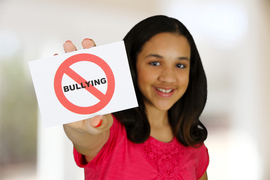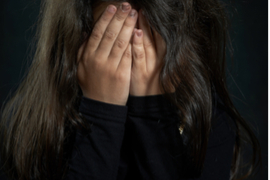The Other Face of Bullying
Before we get into the serious topic of sibling abuse, we want to offer you a free tip sheet on “Five Things Successful Kids Know About Bullying.” It’s FREE. Download it now and get it into your teens’ hands before they need it. Click the button and let us know where to send it.
Now let’s turn our attention to the purpose for this article:
This isn’t your average serious “stop bullying” blog. It goes deeper into a topic we would all like to avoid. Please read to the end for important insight.

During a serious talk about how to handle bullying, my daughter Lily commented:
Lily: I don’t like it when someone calls me stupid.
Me: What would you do if that happened?
Lily: I would Smile and say “Thanks!” and walk away.
Me: Wow! Then they would be left standing there yelling about someone being stupid to the air! Good plan.
Lily: Yes, like powder rolling off your back.
Me: Pardon me?
Lily: You know, if you put powder on your back, and a bug lands on it, it slides down and falls to the ground.
Me: That is very interesting. Did you just make that up?
Lily: Yes.
Me: I like it. Another way to say that is it is like water rolling off a duck’s back.
Lily: I don’t get it.
Me: That’s okay. I like your powder/bug theory better.
Everyone is not bullying.
I had been working with Lily to help her see that everyone is not a bully. She called kids bullies if they even said, “No, that’s not how; let me help you with that math problem.” To me, that is a helper, but to her, that is a bully.
I found a great resource at my friend’s office. She is a therapist and told me to use it with Lily. It went something like this:
- A bully may be someone who feels afraid themselves, so they act tough to make everyone think they aren’t afraid.
- They use their voice, their hands, and sometimes other things to scare kids.
- A bully is someone who tries to make you do something you don’t want to do.
- If someone tries to bully you, stand tall, look them in the eye and say, “I don’t want to be bullied!” If they insist on fighting, walk away.
- Find an adult if the bully won’t leave you alone and let them know what is happening.
I thought that was a good definition to teach Lily. She now has a better understanding of what a bully is. She still calls everyone a bully, but we are working on it.
I feel sorry for our little kids who don’t understand what is happening when they are being bullied. They have heard the word bully many times because it is a buzz word in schools. However, when it is happening to them, they may not put the word and the other child’s actions together. If they don’t, they will not remember the steps to handling bullies. Neither will they tell an adult they are being bullied.
Poor little things! They are busy just trying to figure out how the world goes around, and they come face-to-face with a bully. Let’s give them all the information they need before we send them out into the world.
***
It’s time to take this blog deeper into the subject of bullying.
The Other Face of Bullying
This is a sensitive subject I am covering today, because, parents, I will be asking you to keep in mind that bullies might be in your own families. I don’t mean bullying children outside your home but bullying their siblings to the point of deliberately, physically hurting them. It is called sibling abuse, and it is no longer a rare occurrence.
Occasionally, there is one child in the family who terrorizes the others but only when the parents aren’t around. This could be the oldest child, the middle child or the youngest one.
How will you recognize sibling abuse in your own home?
- Keep the lines of communication with your kids open so you always know what is taking place on a daily basis in your home.
- Remind your kids frequently that they can come to you with anything they need help with, no matter what.
- Watch for bruising on arms and legs.
- Watch the interaction between your children. If one always defers to the other one, tuck that away as a sign.
Two years ago at a conference, I met a woman who grew up a battered child. She was abused both by her parents and her only sibling. I asked her if I could interview her for an article I was doing, and she reluctantly agreed. Her identity, of course, will not be revealed. Listening to her stories is heartbreaking.
Her parents were shouters and physical batterers and throwers. The girls never knew when someone was going to throw something at them. Those parents never hurt each other physically, but the children were subjected to physical and sexual abuse during the time her parents’ marriage lasted.
Pleasant childhood memories were replaced with severe bullying and sibling abuse.
Her memories of growing up with her sister were equally frightening. Her sister would lock her out of the house on cold, snowy days after school, not letting her in to go to the bathroom or do her homework. She knew that every day after school, while her parents were at work, her sister would hurt her with something – her fists, a broom handle, metal hangers or knives.
No place in the house was safe for her, but each day, as she ran from her sister, she hoped she might find somewhere in the house to hide. When she realized she wasn’t going to get away, she would try to protect her face and head but would incur bruises and cuts on her arms and legs as a result. On another occasion after being hit on her fingers with a broom handle, she ended up with a bone chip in her finger and never told anyone.
Another time her sister threw a knife at the back of her head. Her head wound bled profusely, and she said blood seemed to be everywhere. She frantically tried to clean it up while her sister stood over her and shouted, as she had many times, “You better get this cleaned up and you better not tell mom, or I will kill you!” Apparently, she had no doubt that would happen, because she never mentioned anything about her sister to her mother. Home had become a place of terror rather than a place of peace and safety for her.
Why was sibling abuse occurring in her home?
Why did her sister only feel satisfied each day after she had beaten her up? Was her sister taking her frustration out on the only person who would not hurt her? It would seem that they could be allies, watching out for each other. But that isn’t what happened. Since the parents were abusive, she may have simply been trying to hurt them by hurting her sister. Unfortunately, her sister was at the bottom of the abuse chain and had nowhere to turn.
When she was young teachers were not trained to watch for signs of abuse, so she was correct in her assumption that there was no one on earth who could help her. She just had to wait until family circumstances changed so she could be safe. That is simply tragic.
If you have a child being bullied in your home, and they are afraid to come to you for any reason, that child will feel as though there is no ally for them in the home.
Remember, it isn’t just bullying or sibling rivalry at that point. It is sibling abuse.
Home is no longer their safe haven. They can’t fully relax and be themselves after school because they know they are facing a worse foe at home than those at school.
Working in the court system afforded me many opportunities to work on cases involving child-on-child sexual abuse and sibling-on-sibling sexual abuse. This is a startling thought, isn’t it? It is the step beyond sibling abuse. How could that happen? I want you to be aware that this is more common than you might imagine and cries out for parents who stay totally connected to their kids as they grow up.
It may be hard to believe sibling abuse or even bullying is happening in your home.
I know it is hard to believe that a child of yours might be abusing another of your children. I am simply asking that you acknowledge it can happen. Just as with domestic violence, sibling abuse happens in all types of homes. Be as vigilant about what goes on in your home as you are about what goes on at school, and you should be able to discern any problems.
Home is supposed to be the safe place where kids can work out the countless facets of growing up before they move out into the world. Be sure this is a reality for your children, parents. Be on the alert – each one of your children is trusting you to take care of them.
I told you this would be a difficult subject. It is, however, a side of bullying that I have not seen explored before by the myriad of anti-bullying campaigns. I wanted to share it with you. If you were the victim of sibling abuse, you know how serious this topic is.
Help me spread the word about this hidden abuse and perhaps spare other children from suffering. Please feel free to pass this blog along to your families and friends. Send them this link: https://claudiathomason.com/the-other-face-of-bullying/
Sibling abuse will only stop when it is acknowledged as a problem and addressed properly.
If you suspect sibling abuse, at the very least, get your children into therapy with a reputable therapist. As a victim advocate for twenty years, I have handled cases of sibling abuse that were prosecuted because of the sheer severity of what one child did to another on a regular basis. It needn’t come to that if you take steps to get help for your children.
As a Certified Parent Coach, feel free to reach out to me. Perhaps together we can form a plan to assure your children’s safety and well being. Write to me at info@claudiathomason.com
***
For tips for teens on how to handle bullying, send for our free
To check out my Amazon Author’s Page for my books, CLICK HERE.

Leave a Reply